ZHdK IAD 2 semester / Ramona Rüttimann / David Wollschlegel / Baran Güneysel / Mai Watanabe
Don't wanna be here? Send us removal request.
Text
Week 6 – Production Week 2
We edited over the weekend and yesterday evening a raw cut with the existing material. We are glad that we have more than enough material to express the experience in the movie. The feedback we’ve got from the audience and our mentors was good.
The movie itself should not only express the experience but also explain the experiment a bit. The current movie lacks that a bit.
We agreed further to design and develop a simple website, which contains all the information around the project, some lessons learnt and a step to step guide, how someone else can host those meetings.
0 notes
Text
Week 5 Production Week
This week we specially wanted to test our prototype and evaluate it. On Tuesday we discussed that we want to do the drawing dates on the following days: Tuesday, Wednesday and Thursday. We offered our participants timeslots from 9.30 until 21.00. We told them that the experiment will approximately take 20-30 minutes, so that we have enough time. We didn’t want to give them to many information about what will happen, so that they are as openminded as possible.
Here is the task they had:

They met in zoom were one of us hosted the whole drawing date. They were not allowed to put on the webcam and should only use their surname while participating. We asked everyone if it is okay that we record everything and might use their video for our end-movie. We were really happy that nobody said no to this agreement.
After that we explained, what they have to do and how they are able to draw together in zoom. After 15 minutes (sometimes a little more) we went back into the meeting and asked them if they want to do another round. This were the questions for the second round. We decided these questions together and wanted to ask them something about their present, their past and their future.

On Wednesday we chanced the first round to the second and the other way around. Within two days we had 32 participants, that means we hosted 16 experiments. Nearly everyone was really excited, this was a mood booster for our team. After the experiments we asked the participants if they want to see each other, because many of them were wondering who is behind the voice they talked to. And we had some questions how they experienced the drawing date. These were the questions we asked the participants:
How was this experience for you?
What did you like?
What did you find bad?
Would you repeat the experiment later again?
Did drawing help you answering the questions?
Was the time sufficient for the exercise?
What do you think about the asked questions?
What do you take with you after participated in this exercise?
Would you stay in contact with your drawing partner?
We were happy that we got so many nice answers. People really enjoyed the exercise and wanted to do it again or gave us feedback that is helpful for evaluation.
Here an example from the participants work:

After every experiment, we watched the recorded sessions and analyzed them. We noticed certain patterns in the answers the participants gave. When the question “If a crystal ball could tell you the truth about yourself, your life, the future or anything else, what would you want to know?” was asked, usually one member would say he/she would be curious to know how or when they die, and the other participant would react with disapproval, stating that it would be better not to know such things. Many thought that not knowing certain things would be better than knowing them. That question was usually really hard to answer for the participants. What we also noticed is that when a participant was hesitant to open up about personal matters, when the other participant started to talk about personal things the hesitant one would also slowly open up. If they felt judged by the drawing partner, if they got often interrupted, or they felt the other participant was not taking the question or experiment very seriously then they would also be more reserved with the answers. It was really about the chemistry the two participants had on how well and how long the sessions went, and if they wanted to continue with the second round of questions or would be willing to show each other by activating the web cam. The participants would usually be more comfortable when speaking in their native language. We started to select some scenes that we found particularly interesting and started to translate them in english to make them universally understandable since the languages that were spoken varied from Italian, Greek, German, and English.
0 notes
Text
Week 4 - Storyboard
Tuesday
This week topic was about stories and users. Those two terms are both found a lot in the world of design – like user stories, user experience, storytelling or storyboards. On the last two we focused on this week.
First, we got an introduction about storytelling. Especially the fortune diagrams and the eight rules of writing / storytelling by Kurt Vonnegut stayed in our mind.
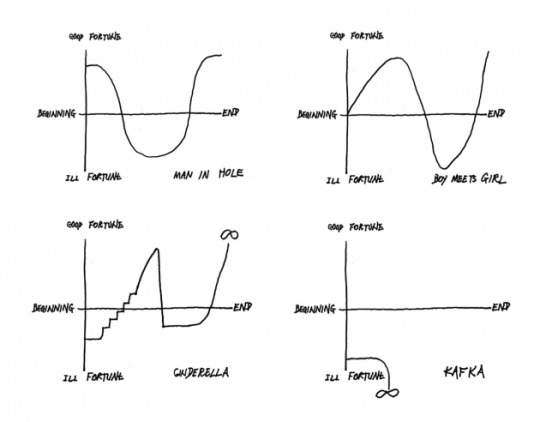
In the afternoon we had a short input about storyboards. Storyboards are used by designers to tell how someone uses a product or how a product is used.
Storyboards are great to communicate an idea. For example, when looking for investors, to whom you have to sell your product. But also explain how the product works to the user.
But most importantly, I like how creating a storyboard can show the designers missing pieces in the product. Creating a storyboard, the use of the product has to be described from point A to point B. If there are logical errors in the process, they become pretty obvious fast.
It is easier to understand a story then receive the key features of the product and put them together in your own head and then resulting in a different picture than the actual idea.
If a storyboard is created, the following points should be remembered:
For whom is the product designed?
Which problem will be solved?
What is the topic?
Is the story chronologically or topic orientated?
Me or narrator voice?
What is relevant?
How formal and what content?
Most importantly something needs to change in a story. If nothing happens or provides a value to the viewer it gets boring.
After the introduction we had one hour to create a storyboard of our product. Because our end product is a movie about the experience people had, meeting strangers, answering questions and draw together, we created a storyboard of our final movie. This was quite hard, because we didn’t really know, what the material from the experiment will offer.
In the following mentoring our storyboard was considered as good and we mainly received feedback for our call on how we want to gain people for our experiment.

I really liked that we should consider not using the word “experiment” because it sounds boring, exhausting and not funny. Our mentor suggested the term “action research”, which sounds a lot more interesting and entertaining. Also, it is not a term that people are very familiar with. Furthermore, our flyer design looked too bureaucratic because it was designed on the DIN A4 format. We improved on those two points.

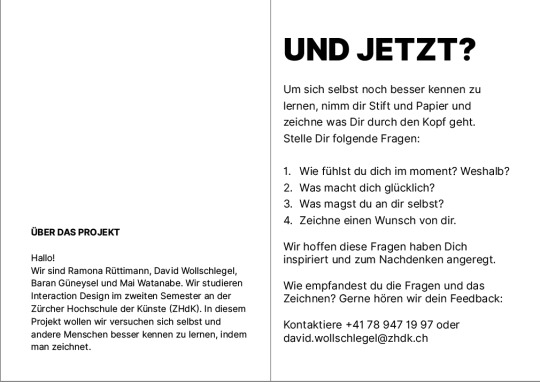
Wednesday
On Wednesday we also improved critics from last week. For example, the fact that our questions were not suitable for drawing or simply to boring. We found the “The 36 Questions That Can Make You Fall in Love with Anyone» by Arthur Aron. Those questions are a lot more personal and interesting, because they are not every day small talk questions. We picked and agreed on three questions we want to use further in our experiment.
Draw three things you and your partner appear to have in common.
Share with your partner an embarrassing moment in your life
For what in your life do you feel most grateful?
Thursday

On the next day, we posted again a call on Instagram. And the feedback from Tuesday worked. We got a lot of reaction and people signed up fast. In a short time, our WhatsApp group turned into a wall street broker place where we matched the people signed up to others.
“I have someone speaking English and he would have time at 4pm” “I have someone at half past 4, would he also be free at that time?” “Yes.” “Perfect!”
During this day we easily gathered 20 people all participating in our action research.
The feedback was great. They had fun. But they marked, that the questions could be more personal. Roughly half of the participants criticized the drawing. They did not saw a benefit in it. But they liked it anyways.
Most of the people first discussed verbally about the questions and then draw. Also, they helped each other on how they can visually represent the answer.
Some people would like to see each other after the experiment.
Participants answered more often that they would like to stay in contact, compared to last week, when we used the old question set.
Friday

We created our presentation in the morning and in the afternoon we presented it.
0 notes
Text
Week 3 - Play
On Tuesday we started with the first Exercise Prototyping Ideas. We had 40 minutes time to prototype our idea.

Our idea for prototypes has given us other questions with which we can further develop the idea. We should try to see what already exists, a lot of tests, what the people feel like.
The feedback from Joelle was: You just need to try different setting. Time? Does it like to be an activity with time? Is there purpose? Awareness plus extra. What leads into the moment , connecting, feelings better. What is the end effect?
Based on this feedback, we focused on the following questions and did desk-based research:
Phantom pictures, personal characteristics? What do draw?
What interesting tasks can we create?
→ Self reflection?
→ Collaboration
→ is there anything different?
Collaboration
→ What improves collaboration?
Connect strangers —> How do they do it?
Collaboration
→ What improves collaboration?
→ What does exist
In our desk-based research, we have used various existing drawing tools to see the other ideas. In this research we found out different aspects of how the strangers can befriend others, or other exercises like Art Therapy or Drawing as Team - one person has an object in his hand, and describes to the other. The other person has to draw the description without seeing - We had this exercise in our first module as well.
Self-reflection is a broad topic, perhaps we are a tool for mindfulness which Sigmund Freud also called uncritical self-observation.
f.e: Personal things:
Drawing yourself in 5, 10 whatever years.
What people do you see yourself with in 10 years?
Draw what's on your mind right now.
Draw a positive characteristic of yourself.
We were interested in the topic of self-reflection and as a topic it would fit very well to give people tasks that they do with strangers, with the aspect of uncritical self-observation, so that one gets to know oneself and the stranger better and asks oneself the questions.
Experiments | Cultural probe 3 Tasks Stranger A, Stranger B, Stranger C, Stranger D Task 1, Task 2, Task 3
EXPERIMENT 1 stranger A connects with stranger B, first day they have to make task 1, second day they have to make task 2 and third day task 3. They talk through the microphone. After we ask them how their experience was, if they felt like they bonded and know each other a little now and if they want to keep in contact with that person.
EXPERIMENT 2 stranger A connects with stranger B on the first day for task 1, on the second day with stranger C for task 2, on the third day with stranger D for task 3. After we ask them how their experience was, if they felt like they bonded and know each other a little now and if they want to keep in contact with the people. Ask stranger A if he prefered the experiment 1 or the experiment 2 and why.
First experiment with our first participants
In order to get first impressions and to see how the idea of self-reflection through drawing works, we did an experiment with two anonymous participants. They did not know each other. They both ended up with a collaborative drawing tool, and their microphones were open - they communicated with microphones. The following questions were asked in order and for each question 3 minutes were given. The participants were asked to answer the questions with drawings.
What do you like about yourself?
What is important for you?
Find a situation or a place where you two could meet.
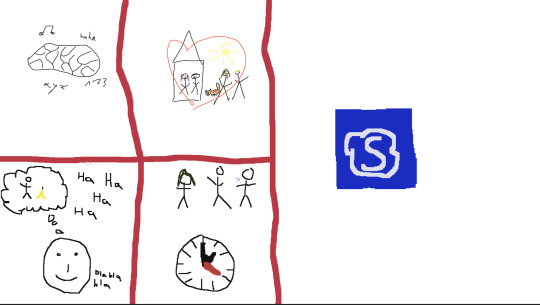
After this experience, we asked following questions and got following answers:
How was the experience?
It was funny, specially to have a task with a stranger.
It was something different and funny.
Were you comfortable during the experiment?
Yes I was comfortable.
I was comfortable.
Would you do it again? (With the same person or a different one?)
I would do it again, even with someone else.
Yes, anytime with anyone.
Was the drawing helpful to answer the questions?
I think so, it was sometimes easier to draw it than to say it with words.
Due to my skills I felt limited drawing, but comparing images was funny.
Would you like to get in contact with the other person?
I don’t know why I should.
No, I do not plan to.
Was the time limit okay or would you rather have more/less time?
I think the time was perfect, this way you hadn’t much time to think about it and just have to start drawing.
For the questions the time was sufficient.
Our goals for this project are:
People shouldn’t think about these questions alone.Drawings should support the thinking and help them through conversations with strangers. Participants should think about themselves and about the questions even after the experiment.
According to the above answers, we can observe from the first experiment that the participants sometimes find it easier to answer the questions with visual language, like drawing or comparing images. We could not determine whether the participants asked the questions after the experiment.
Self experiment
At the same time we did our own experiments. From 9 o'clock in the morning until 10 o'clock in the evening we drew our moods every two hours. The results are here:

On Friday we did a live prototyping again with two anonymous participants, who both did not know each other. After the experiment we asked them the following questions:
How was the experience for you?
Really exciting, but the tools. Drawing and talking at the same time was hard.
What did you like what did you find bad?
I really liked talk as stranger, it’s really interesting. Online drawing tool was hard.
Right now we didn't go deeply Maybe too private to talk something about? They will not going about their last dream.
Did drawing help you answering the questions?
I dont really know if it was helpful. Thinking deeper and talking about it with someone.
You have topic how to talk but you can’t draw.
These are really abstract topics and they are really hard to drive.
It was drawing together at least at the same time.
Drawing in the short time and what you are going the draw. For now in this case it was really good to have two different spaces to have.
What do you take with you after participated in this exercise?
Now you know about how you feel right now and I know what
The interaction I liked. I don’t think that I learned about myself, maybe I talked about those topic too much in the last times.
The same exercise were also made individually by our classmates answering one of this questions in 3 mins:
What do you like about yourself or what is important for you?
What is your mood right now?
What was the last dream you had, that you can remember?
They have uploaded their drawings anonymously here:
https://drive.google.com/drive/folders/1Gsy9rAXcSNhXT8JP7IfBtz8GRuMbXmv0
0 notes
Text
Week 2 - Idea Transfers
On Tuesday we had an input about rapid prototyping. Due to the Monday lesson this week we already know what prototyping in design means. So we just want to repeat briefly what very rapid prototyping should be:
cheap
fast
“quick & dirty”
But pay attention this term is also used in architecture, engineering and industrial design, where it means to make a 3D model or print, or even making a CNC-Machine product.
After that we talked about what kind of waste we all have at home, because of an exercise we had to do later. So we listed a few things:
used paper
used cardboards
plastic bottles
plasticbags
old clothes
dirt
stones
decorative objects/gadgets
old projects repurposed
food scraps - compost
The exercise was create a prototype, that might be useful for our project. We got 25 minutes, to meet up, think about something that could help us for our project and to create it. We were excited about the exercise and had fun doing it, even though we had to do it via zoom because of the circumstances.
So we thought how it would be if the presenter has a tool at home like the picture underneath that gives him a feedback how he the audience is feeling at the moment. Scans of the faces would calculate the mood from the participants. And there would maybe a screen filled with colour to sum up all the results.
Of course not everything was worked out yet, especially because we do not have any experience about face recognition. The opinions from our classmates was very varying some of them found our idea funny and nice but others did not like the fact that the camera is tracking their face expressions all the time. Also because it is really hard to look happy or interesting all the time even though you might feel that way. So we had to think about a different idea how to give the online presenter a feedback. In the pictures below you can see our project.


After the exercise with the rapid prototype we had to do another exercise that should relate on body storming. So we tried to put our thoughts in action, we asked our selfs simple and important questions by acting them out. We still wanted to stick to the same idea than the rapid prototype but consider the feedback we got. Therefore we used google presentations and made the following graph:

With colours we tried to make it easier for the presenter/teacher to see, how the students feel at the moment. We categorised it in interesting with the opposite boring and understood with the opposite didn’t understood.
Each person can now move a circle in the graph depending how he feels about the lesson or presentation. Also you could ask a question anonymously, what could encourage the students. This is how it could look like during the lesson/presentation:

For our presentation we ask Baran, if he could present his presentation from Monday again and get him self filmed. Know he had three monitors in front of him, one with his presentation in zoom, one with his own notes and one with the graph, how we feel like during his presentation. Here the video of our presentation:
youtube
After presenting our idea we talked about it with the other students and Joëlle and we determine that this prototype would have the following advantage and disadvantage:
advantage:
you often ask you self if the people understood you, that is why this tool could be useful
anonymously could encourage the students to ask more questions, what could lead to a better understanding of the topics
disadvantage:
the monitor with movements could be a distraction
the categories interesting and boring are not well chosen, because it could hurt the people or demotivate them
It was a nice to experience, how body storming can influence us. It kind of helped us to decide, that we rather would do something that helps people to connect with one another, also that might could be used in therapy. Therefore Baran had an interview on Thursday morning with a Therapist from France. In advance we collected all the questions we wanted to ask her on a google doc. The questions mainly related to the theme how therapy is now with the quarantine. If you want to read the whole interview follow this link, these are the notes, that Baran took during the talk, as well as more Informations about the therapist:
https://docs.google.com/document/d/12dhFKBWoOzrCzolXCmbfiEy3i71fNiwoBf48Wz66vPE/edit
Mai, David and Ramona were gathering many informations about what kind of therapy there are and specially what kind of creative therapy there is. The pictures below are related work we founded to the topic that was interesting for us. The left part of this pictures are informations we got from this website, on Thursday 2 April:
https://www.dezeen.com/2016/11/04/tools-for-therapy-nicolette-bodewes-tactile-object-psychotherapy-dutch-design-week-2016/
The right part we got from a research Paper about Drawing in aphasia: moving towards the interactive from the author Carol Sacchett from the year 2002.

The four of us discussed together in what direction we would like to go with our project and what we would like to achieve. Before that we had to reflect where we come from and what informations we collected. So here our review:
We started with the themes: Therapy - Healthcare - Help with Technology
In the first week we were busy with these topics: How we can help with loneliness / boredom
In the second week we changed to: How we can help with loneliness and the lack of social “connection”. Due to the phone call with the therapist we realised that boredom is not really a problem, but the feeling of intimacy is and that there is a Lack of “connection” → less intensity of emotional expression, because of the online therapy.
That is why we decided, that we would mix these two things together:
Tool that helps communicating with friends
Tools that help communication in therapy (Therapist and Patient)
The result for us was that we want to create a tool that helps with non-verbal communication (visual, drawing), for everyone and could be used in therapy.
We did not want to make another survey, for one because we think this time it is not the right tool to use and because we wanted to make a small experiment with our friends. We sent them the following message:
Hi, as you might know, we are currently working on a project in our module Interaction Design Process for our studies at the ZHdK.
It would be nice if you would take part in our game. Just sit down for a few minutes and draw something that makes you happy.
We collected all the drawings until 21.00 and sent a different one, to all the other participants. So we are like a network that spreads different drawings to all the participants that do not know each other. The outcome was impressive and really nice, nobody was disappointed of what they got and a few of the people were grateful as it was a little gift.
Here are a few examples how the people reacted:


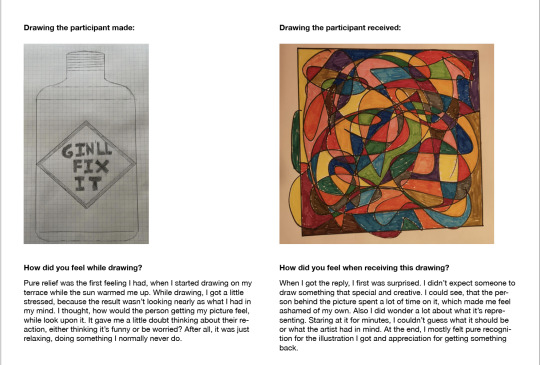
The rest of the results getting uploaded in the next few days on this link:
https://drive.google.com/drive/folders/1OSdkQlrKfr2PRkMS_GlW6xiBQt7i_HxN?usp=sharing
For the next four week we had planed the following things:
Experiment Drawing-Date; We would like to give a view households the task that they have to make a painting or a drawing together, so they feel more connected to each other. This would be the task:
They have to pick one of these options:
Draw whatever you want together
Draw each other
Draw a landscape together
After that they have to answer these questions:
How was this experience for you? (Fun, Intimate, Frustrating)
Did you enjoy it?
Did you feel like you bonded during this task?
The Material they would get would be: paper, two coloured pencils (1 colour per person) / or finger paints, candle (because it is a date)

Further we would like to make a self experiment, where we draw our mood every two hours, from the moment you wake up to the moment we fall asleep. We have these expectations:
seeing a pattern in the time of the day and the mood
helps to unwind and turn away from the screen for a while
helps to understand and know oneself better
And of course we want to make more desk-based research into non-verbal visual communication. So we get to know and understand more of this topic.
This week was a real roller coaster with many up and downs. But finally we know in what direction we would like to go and everyone is motivated for the following weeks.
1 note
·
View note
Text
Week 1 - Into the Wild!
The first day conducting field research we wanted to focus on our main interests for our project. We agreed that an AI-based application to create a sensation of help, not to replace therapy, but more companionship would be a suitable idea to pursue, seeing the current situation. For two weeks all citizens, who do not work in a field that is viewed as essential, have been constrained in their homes. When this quarantine will end is uncertain. This to maintain a social distance and avoid the spread of COVID-19. In these moments, people have to start to deal with a situation of isolation. We thought that loneliness and boredom could become a growing problem for general wellbeing.
We wanted to get in touch with a wide variety of people. We got in touch with persons from the age of 14 to 80+. We were interested in how the quarantine is affecting people’s behavior and mood. If the restrictions and disruption to their daily routine would affect them negatively. We thought of a set of questions that could give us a first overview.
· Who are you? (age, occupation)
· Who are you spending your quarantine time with?
· how has your everyday life changed since the quarantine?
· how does quarantine affect your mood?
· What do you do to improve your mood at home?
· Where would you rather be right now?
We wanted to contact workers who are working at home, workers who are still working outside, students, retirees and unemployed. We wanted to discover if there were any patterns with the answers. Our Expectation was to recognize categories of people who react and respond in a similar way (I am fine, I am not fine).
Phone Interviews
David got in contact with seniors who live in a retirement home, through his mother who works there. He conducted 4 interviews through the phone, all respondents were over 80 years old. Two of the three people are fully cared for and the third person lives in an apartment right next to the home. The fully cared for people had difficulty understanding my questions and could not answer open questions. We think it would be better to do something visual and have contact in real life. Because of the coronavirus, we have to find out how this could work best. Cultural probes could be one possibility. Here a snippet from an interview:
vimeo
Getting information from the people in the home was very difficult. A visual Observation in everyday life would be more effective.
Themes: occupation, entertainment, social interaction, time for oneself.
The statements on the phone seemed quite cold. One notices the loneliness and possibly also boredom. The question whether they would appreciate it, if acquaintances would call more often, they would say yes. But can one trust this answer? Do they answer honestly or is it just politeness?
Person 1 Occupation: - Read - Number game (Lotto, Bingo) - Wandering around the home - Set the table! ⇢ Feeling needed.
Person 2 Occupation: - Lying / dozing - „zvieri näh“ - Talking to people - read the Bible The situation is calm and "grave". She prefers to make phone calls. She doesn't want a change now. "It is the way it is" is probably the most heard sentence in the conversations. She says the situation hasn't changed much since the quarantine: she still and always felt a sense of helplessness. She takes each day as it comes and still is alone. Residents have the same perception of the atmosphere in the home as before.
Person 3 Terrible not being able to see anyone. Still meets with the neighbors. No longer allowed to have lunch with the other residents. "Unecessary information" comunicated. When I was asking if she is using the phone, she told me about her phone provider and how much it costs, even thought that was not part of the conversation.
Person 4 Made more shopping, to prepare. Everything is still working normally. Says that 15 and 16 year olds have no trouble at all.
Video Interviews
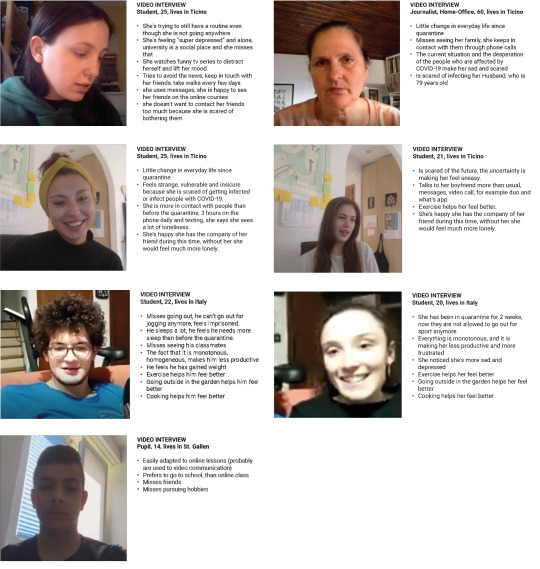
Conclusion
For 1/3 the quarantine has brought little change in the routine.
1/4 misses the direct contact with classmates
1/7 misses seeing her family
1/3 is more in virtual contact with people than before the quarantine
1/3 is feeling less productive because of the quarantine
2/3 are scared of the current situation and of the uncertainty of the future
What helps to lift the mood
2/3 feel better when they exercise
1/3 contact with people online and thorugh the phone
1/3 feel better when cooking
1/6 feel better through entertainment (tv shows, games)
Instagram Poll
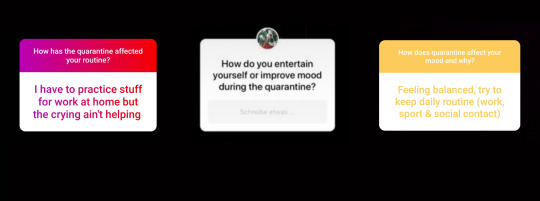
We decided to ask three short questions in our Instagram poll, here are the answers we got:
How has the quarantine affected your routine?
From lab work to home office for paper research and report writing, from fitness center to jogging and online courses
Routine has become really important to keep the feet on the ground
Home School :D
Can’t go outside for no reason, little afraid to visit my parents and sad that I can’t see my
grampy’s
Saving time and money. At work: slowly losing immediacy with clients and colleagues
I can not meet my friends and family :’(
I have exams in June and I have no clue of what will happen because I’m doing online school but it’s literally 2 hours a day (I live in Italy)
All activities acquired the same value: it’s not worse to wash the dishes than take care of plants
I have more time, I go to sleep later however less structure
Watching Netflix more
I’m more concentrated during lessons
0 change. I’m a natural isolationist. I was born to do this.
Got more time to read and spend in the kitchen now
Almost nothing changed
I have to practice stuff for work at home but the crying ain’t helping (hairdresser)
I discovered that I’m a morning person, I started making the bed
100% smart work, self-quarantine for every individual of the family
How do you entertain yourself or improve mood during the quarantine?
Playing chess
Watching Netflix
Watch “dumbest purchases I made in my 20s” videos to feel better about myself
Self-penetration
More cooking and eating
Dreaming of me jogging
I plant mushrooms in my garden
Drinking alcohol
Youtube workouts and yoga apps
Watching porns
Playing switch, doing sports and reading books
Scrolling through social media, chat a lot, movies, sit on the balcony, rearrange and clean home
Playing sims
Online apéros
How does quarantine affect your mood and why?
Negatively because I can’t go to restaurants/clubs or travel
I am nervous cause I see the same people all the time and staying in the same rooms
All good
Everything is fine, I work from home but at the weekends it gets harder and if the weather is bad
Feeling balanced, try to keep daily routine (work, sport and social contact)
I recognise that I can’t go outside, especially in the evenings I am tired
Sitting in front of a computer the hole day is exhausting
My mind is very relaxed, because I don’t hear the word corona all the time
Sometimes a bit lonely, then I call someone, and I am happy again
There is nothing better than this situation, let’s go for a drink after everything
Doesn’t affect me, because I throw a corona party every weekend
I can still work, so I am not that quarantined. I know what to do
The quarantine is not the thing that is annoying, it is the way how we have to work from home, everyone expects you to be online 24/7
More difficulties to get up in the morning, more exhausted in the evening
Sometimes I feel irritable or anxious, but most of the time I feel relaxed and good
I am not in quarantine I have to work
I watch more Netflix
Video Diary
youtube
Ramona asked a friend of hers to document her day with her phone camera. This was a quite playfull and fun way to discover the routine of a student who now has to stay home, for both us researchers and for the subject. In the video she says she mostly works on her computer. To lift her mood she goes outside in the garden to catch some sunlight. She’s trying to stay positive and that seems to work.
Google Survey
Click here to see all the answers. 61% answered positively - they are well 19% answered negatively - they are not doing well 19% answered positively and negatively. Either they are doing medium well, or they are slowly getting quiet, or sometimes good and sometimes bad. 71% of the people left their contact datas, if we want to contact for new survey.
Feedback from a psychologist: “What answers do you hope to get? Maybe give someone to read again, so that it is clear, everyone is understood correctly. Questions 1 and 3 are a bit similar. If you want to get more out, a reward would be helpful. From a psychological point of view what is important is anonymity, if any sentence is written that the whole thing will be treated anonymously if you don't give your email address. Added: either people don't fill this out if they think it’s too uncomfortable. Answers become more honest when anonymity is guaranteed”
Feedback from a anonym participant: “Quantitative surveys are easier to evaluate with multiple choice questions.” A lot of participants left their email address if we wanted to contact them. We were quite surprised how many participants left their contact.
Send a picture of what you are doing
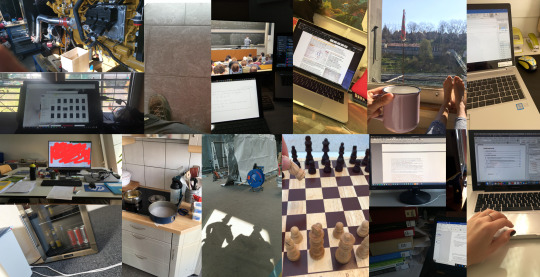
We asked 13 people to send us a picture of what they are doing. Most of them are young adults, some of them are employees, most are student. We can see that most of them stay in front of a screen. Some are playing board games, other are cooking, taking a break of pursuing their hobbies.
Facebook livestream
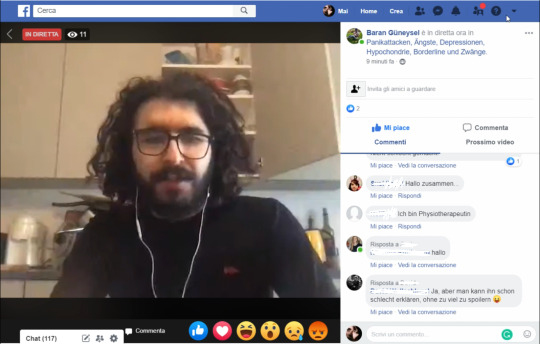
We saw in this facebook group that many users did livestreams. They talked about their personal lives and communicated with the viewers who were commenting. We tried to go live and engage in a conversation with the members of that Facebook group. To start a conversation and get viewers to answer questions was very hard. This is probably because the main focus of such a livestream is the livestramer and not the viewers.
Why did we select those highlights?
Instagram Story Questions We liked the spontaneous answers people gave us. Also the length of the answers is limited so people have to focus on the core of their statement.
Google Forms Survey Interesting more in depth answers. It is easy to share the survey link and therefore can reach people outside of our bubble.
Video Interview The interviewed people are more freely to communicate compared to a phone call. They can show environments or objects through the camera. Furthermore the interviewer and the participant are “closer” together.
Audio Interview Negative highlight. It should that not every medium works for every target audience. Elderly or children would probably benefit from communication mediums where they don’t have to articulate sentences.
Were the expectations fulfilled?
Like expected the answers to our questions were very different. Most people were relaxed and others are scared and sad about the quarantine. Most people know how to entertain them self. Most people feel bad to have social distance and are afraid of infecting someone.
Which changes have to be made?
We need to find a better way to improve trust, so that we are able to ask morepersonal questions. Furthermore we need a better way to express more “hard to explain” topics like loneliness in the online medium. Maybe it would be a good idea to have group discussions and we as the interviewers stay in the background. Especially when talking about difficult topics.
Older people (some have slightly dementia) are having difficulties to answer to open questions. Furthermore they are not so technical advanced that they could use smartphones or other tools to communicate in a more visual way. A way to get a better understanding of their situation would probably be cultural probes. Unfortunately we can not meet them in person, due to the coronavirus.
We want to test if anonymity could help to communicate more personal topics.
What could be the next steps for field research?
Inform better about the topic communication.
Discovery: What is on the market that is used for communicating online or online multiplayer games.
Explore how people in different living situations (home-schooled, home-office, still working outside, retired and unemployed) use communication tools (which ones? for what purpose? how often?)
Unpack your topic further, see what angle you would like to look into
Playful humorous communication, connect people who are in a similar situation orhave similar interests and bring them to communicate and play with each other.
How do you want to get in touch with people online? How do you find your online community?
Contact people we personally know
Use Online Forms
Use social media to find interested people
Friends of friends
Public online groups
What type of media could you use to collect and record your impressions (chats, online video, sound, a mix of different media, etc..)
Chat
Video Interview (single and groups)
Telephone Interviews
Video or Photo diary
Cultural Probes (notebook, drawing and writing down thoughts, giving theminstructions on the pages)
1 note
·
View note